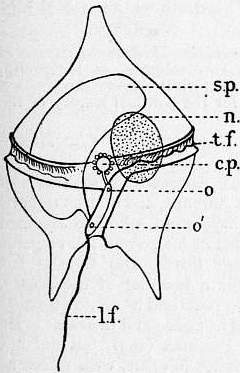|
Ebriid
The Ebridea is a group of phagotrophic flagellate eukaryotes present in marine coastal plankton communities worldwide. ''Ebria tripartita'' is one of two (possibly four) described extant species in the Ebridea. Members of this group are named for their idiosyncratic method of movement (''ebrius'', "drunk"). Ebriids are usually encountered in low abundance and have a peculiar combination of ultrastructural characters including a large nucleus with permanently condensed chromosomes and an internal skeleton composed of siliceous rods. The taxonomic history of the group has been tumultuous and has included a variety of affiliations, such as silicoflagellates, dinoflagellates, 'radiolarians' and 'neomonads'. However, molecular phylogenies place them within Cercozoa. Taxonomy Order Ebriales * Family † Ammodochiaceae Deflandre 1950 mmodochiidae** Genus †'' Ammodochium'' Hovasse 1932 'Tripodium'' Hovasse 1932* Family † Ditripodiaceae Deflandre 1951 itripodiidae** Genus †'' D ... [...More Info...] [...Related Items...] OR: [Wikipedia] [Google] [Baidu] |
Dinoflagellates
The dinoflagellates ( Greek δῖνος ''dinos'' "whirling" and Latin ''flagellum'' "whip, scourge") are a monophyletic group of single-celled eukaryotes constituting the phylum Dinoflagellata and are usually considered algae. Dinoflagellates are mostly marine plankton, but they also are common in freshwater habitats. Their populations vary with sea surface temperature, salinity, and depth. Many dinoflagellates are photosynthetic, but a large fraction of these are in fact mixotrophic, combining photosynthesis with ingestion of prey ( phagotrophy and myzocytosis). In terms of number of species, dinoflagellates are one of the largest groups of marine eukaryotes, although substantially smaller than diatoms. Some species are endosymbionts of marine animals and play an important part in the biology of coral reefs. Other dinoflagellates are unpigmented predators on other protozoa, and a few forms are parasitic (for example, '' Oodinium'' and '' Pfiesteria''). Some dinoflage ... [...More Info...] [...Related Items...] OR: [Wikipedia] [Google] [Baidu] |
Flagellate
A flagellate is a cell or organism with one or more whip-like appendages called flagella. The word ''flagellate'' also describes a particular construction (or level of organization) characteristic of many prokaryotes and eukaryotes and their means of motion. The term presently does not imply any specific relationship or classification of the organisms that possess flagella. However, the term "flagellate" is included in other terms (such as " dinoflagellate" and " choanoflagellata") which are more formally characterized. Form and behavior Flagella in eukaryotes are supported by microtubules in a characteristic arrangement, with nine fused pairs surrounding two central singlets. These arise from a basal body. In some flagellates, flagella direct food into a cytostome or mouth, where food is ingested. Flagella often support hairs, called mastigonemes, or contain rods. Their ultrastructure plays an important role in classifying eukaryotes. Among protoctists and micro ... [...More Info...] [...Related Items...] OR: [Wikipedia] [Google] [Baidu] |
Eukaryota
Eukaryotes () are organisms whose cells have a nucleus. All animals, plants, fungi, and many unicellular organisms, are Eukaryotes. They belong to the group of organisms Eukaryota or Eukarya, which is one of the three domains of life. Bacteria and Archaea (both prokaryotes) make up the other two domains. The eukaryotes are usually now regarded as having emerged in the Archaea or as a sister of the Asgard archaea. This implies that there are only two domains of life, Bacteria and Archaea, with eukaryotes incorporated among archaea. Eukaryotes represent a small minority of the number of organisms, but, due to their generally much larger size, their collective global biomass is estimated to be about equal to that of prokaryotes. Eukaryotes emerged approximately 2.3–1.8 billion years ago, during the Proterozoic eon, likely as Flagellated cell, flagellated phagotrophs. Their name comes from the Greek language, Greek wikt:εὖ, εὖ (''eu'', "well" or "good") and wikt:� ... [...More Info...] [...Related Items...] OR: [Wikipedia] [Google] [Baidu] |
